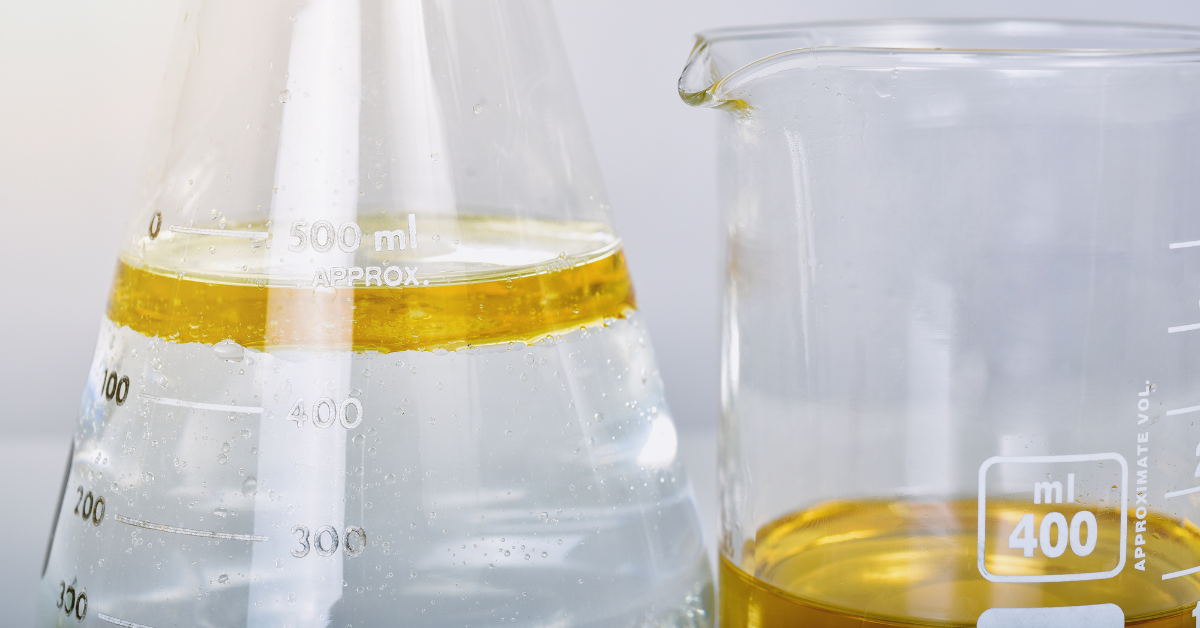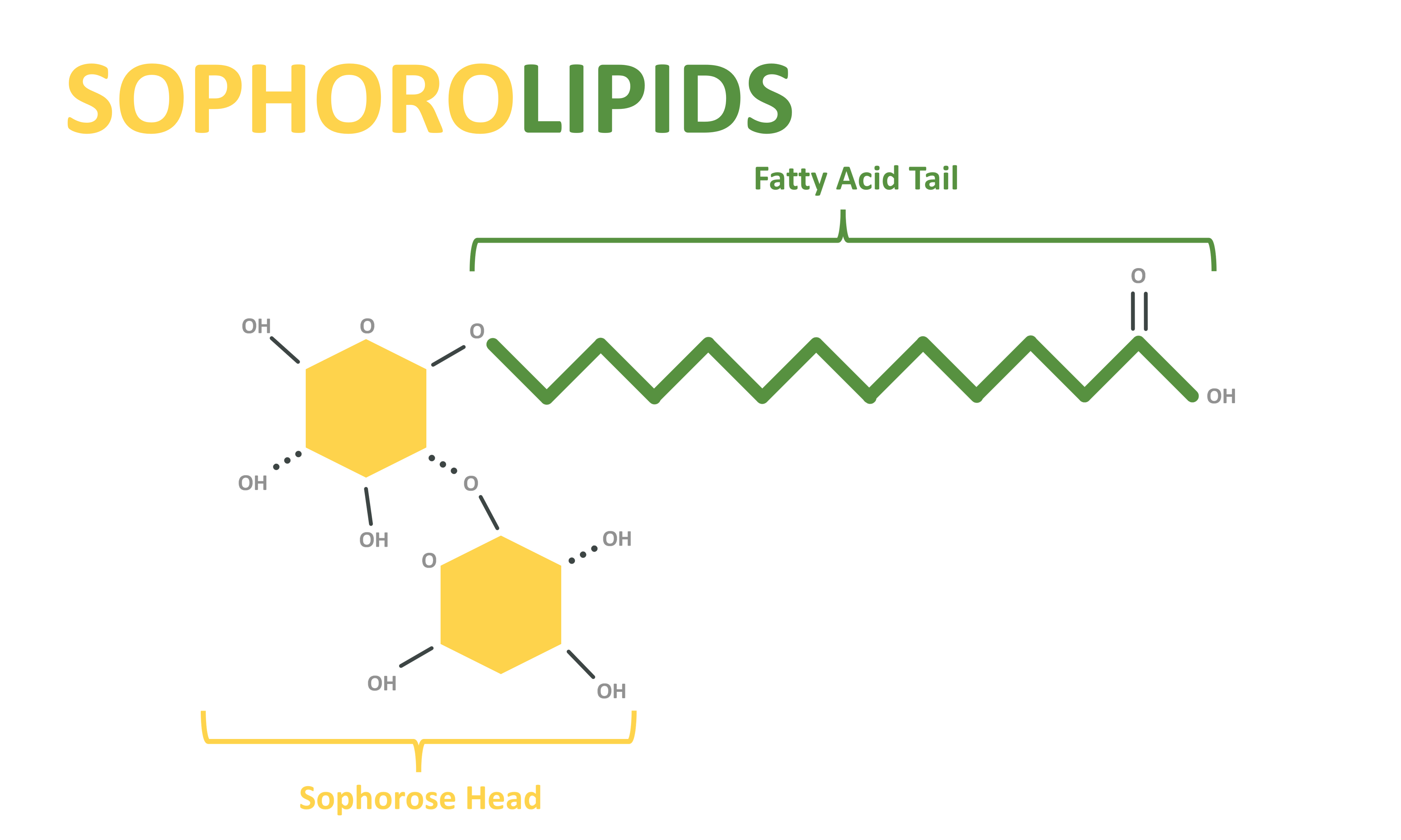
Examining the Versatility of Eco-Friendly Sophorolipids
What Are Sophorolipids?
Biosurfactants are surface-active agents produced by microorganisms such as bacteria, yeast and fungi. Unlike synthetic surfactants derived from petrochemicals, biosurfactants are of biological origin and offer several advantages, including environmental sustainability, biodegradability and diverse functionality.
These compounds have a hydrophilic (water-attracting) and a hydrophobic (water-repelling) region in their molecular structure, allowing them to interact at the interface between immiscible liquids, such as oil and water. This unique structure gives biosurfactants the ability to reduce surface tension and facilitate the dispersion of hydrophobic substances in aqueous solutions.
Biosurfactants can be classified into various types, including glycolipids, lipopeptides, phospholipids and lipoproteins, each with distinct properties and applications. Their production by microorganisms occurs through metabolic pathways, and factors like nutrient availability, pH and temperature can influence their synthesis.
Sophorolipids are a specific type of biosurfactant with unique characteristics and applications. They are a type of glycolipid produced by certain yeast species, most notably Candida bombicola and Starmerella bombicola. These compounds are composed of a hydrophilic head group, typically a sophorose sugar molecule, and a hydrophobic fatty acid tail, see Figure 1.

Figure 1. Acidic, or linear, sophorolipids structure.
Due to their environmentally friendly nature and versatile functions, sophorolipid biosurfactants find applications in a variety of industries, including agriculture, industrial cleaning, coatings and adhesives, metalworking and water treatment. Their role as emulsifiers, wetting agents, dispersants and more makes them valuable in processes ranging from cleansing and degreasing to dispersing pigments in paint.
7 Key Functions Of Sophorolipids
These natural compounds exhibit a wide range of functions that make them indispensable in numerous applications. Here are the key functions and applications of sophorolipid biosurfactants:
1. Coalescing Agents
Sophorolipids act as effective coalescing agents, promoting the merging of small droplets in a liquid medium. In applications like paint formulations, biosurfactants facilitate the cohesion of dispersed particles, leading to improved film formation and enhanced coating properties.
The use of biosurfactants as coalescing agents contributes to the development of environmentally friendly and sustainable products. And unlike their petrochemical or partially bio-based competitors, sophorolipid biosurfactants enable the creation of VOC-free paint formulations. LEARN MORE: Coalescing Agents Transformed: Unleashing the Potential of Sophorolipid Biosurfactants
2. Dispersants
Sophorolipid biosurfactants find applications as dispersants by promoting the even distribution of solid particles in a liquid medium. In the wastewater treatment industry, biosurfactants play a crucial role in preventing agglomeration and sedimentation of particles, ensuring the efficiency of various processes. Their eco-friendly nature makes them a sustainable alternative to synthetic dispersants. Traditional surfactants have long been a source of wastewater pollution.
Locus Ingredients’ Amphi® M sophorolipid biosurfactant is not only helpful in remediation efforts, it has earned the U.S. Environmental Protection Agency (EPA) Safer Choice certification with direct release, which means it is safe to use in any products that are released directly into aqueous environments, bypassing wastewater treatment facilities.
3. Emulsifiers
One of the primary functions of sophorolipid biosurfactants is their role as emulsifiers. Emulsification is the process of dispersing immiscible liquids, such as oil and water, into a stable emulsion. Biosurfactants excel in this task by reducing the surface tension between the two phases, allowing for the formation and stabilization of emulsions. This property finds applications in various industries, from cosmetics and home care products to industrial and institutional cleaning solutions.
4. Ester Solvents
Certain biosurfactants, like sophorolipids, exhibit ester solvent properties, making them valuable in breaking down and solubilizing organic compounds. This function is particularly beneficial in the metalworking industry, where biosurfactants can act as anti-corrosive agents.
5. Inverters
The ability of biosurfactants to alter the critical micelle concentration (CMC) of a solution is known as inverting. This property has significant implications in enhancing the performance of cleaning products and formulations. By modifying the CMC, sophorolipid biosurfactants can improve the detergency and stability of cleaning solutions, making them more effective in removing dirt and contaminants.
6. Solubilizers
Biosurfactants possess the unique ability to solubilize hydrophobic compounds in aqueous solutions. This solubilization property is harnessed in the cosmetics industry by enhancing the solubility of active ingredients. By forming micelles or complexes with hydrophobic molecules, sophorolipid biosurfactants facilitate their transport and absorption, thereby improving the overall efficacy of cosmetic formulations.
7. Wetting Agents
The ability of biosurfactants to lower the surface tension of liquids makes them excellent wetting agents. In agriculture, for instance, sophorolipid biosurfactants can enhance the wetting and spreading of pesticides on plant surfaces, improving their efficacy. This property is also valuable in soil remediation processes, where biosurfactants aid in the penetration and dispersion of water into contaminated soils.
Benefits Of Formulating With Sophorolipids
The Amphi line of sophorolipid biosurfactants offers benefits not available from traditional petrochemical or partially bio-based surfactants. Amphi ingredients are:
- 100% Biobased: Amphi sophorolipids have earned the USDA Certified Biobased Product label for containing 100% biobased, renewable content.
- Nontoxic: Free of 1,4-dioxane, ethylene oxide, formaldehyde and other Proposition 65 chemicals of concern.
- Sustainable: Palm oil free, made from responsibly sourced raw materials, eliminating palm industry issues such as rain forest deforestation and human right concerns.
- Multifunctional: Non-ionic and anionic uses, Amphi sophorolipids can act as primary or secondary surfactants.
U.S. TSCA Approval: What You Need To Know
The Toxic Substances Control Act (TSCA), a United States federal law that was enacted in 1976 to regulate and manage chemicals in the country, provides the EPA with the authority to track, evaluate and regulate chemicals that are produced, imported or used within the United States.
Currently, there is only one U.S. company that can produce large volumes of biosurfactants domestically. The EPA has approved Locus Fermentation Solutions’ (Locus FS), the parent company of Locus Ingredients, TSCA Pre-Manufacture Notifications (PMNs) for its fermentation-produced sophorolipids across a multitude of applications. This includes usage in both industrial and consumer products and formulations.
TSCA approval delivers a sustainability-conscious chemical industry with regulatory compliant biosurfactant solutions that are naturally derived, safe and environmentally friendly.
READ MORE: Maximizing Lab Efficiency
How to Create Better Formulations in Less Time
Lab efficiency is a critical factor for success in formulation. In a landscape where time is a precious resource, optimizing lab efficiency becomes paramount for creating outstanding and innovative products.



